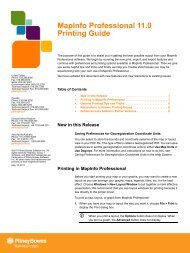Using the Line Style Editor - Product Documentation - MapInfo
Using the Line Style Editor - Product Documentation - MapInfo
Using the Line Style Editor - Product Documentation - MapInfo
You also want an ePaper? Increase the reach of your titles
YUMPU automatically turns print PDFs into web optimized ePapers that Google loves.
<strong>Line</strong> <strong>Style</strong> <strong>Editor</strong><br />
Version 2.0<br />
USER GUIDE
Information in this document is subject to change without notice and does not represent a commitment on <strong>the</strong> part of <strong>the</strong> vendor or its representatives. No part<br />
of this document may be reproduced or transmitted in any form or by any means, electronic or mechanical, including photocopying, without <strong>the</strong> written<br />
permission of Pitney Bowes Software Inc., One Global View, Troy, New York 12180-8399.<br />
© 2009 Pitney Bowes Software Inc. All rights reserved. Pitney Bowes Business Insight, <strong>MapInfo</strong>, Group 1 Software and <strong>Line</strong> <strong>Style</strong> <strong>Editor</strong> are trademarks of<br />
Pitney Bowes Business Insight, a division of Pitney Bowes Software and/or its affiliates.<br />
Americas:<br />
Phone: (518) 285-6000<br />
Fax: (518) 285-6070<br />
Sales: (800) 327-8627<br />
Government Sales: (800) 619-2333<br />
Technical Support: (518) 285-7283<br />
Technical Support Fax: (518) 285-6080<br />
www.mapinfo.com<br />
UK and EMEA:<br />
Phone: +44(0) 1753 848200<br />
Fax: +44(0) 1753 621140<br />
Technical Support: +44(0) 1634 880141<br />
www.mapinfo.co.uk<br />
Asia Pacific:<br />
Phone: 61. 2.9437.6255<br />
Fax: 61.2.9439. 1773<br />
Technical Support: 1800 648 899<br />
www.mapinfo.com.au<br />
Contact information for all Pitney Bowes Business Insight offices is located at:: http://www.mapinfo.com/contactus<br />
<strong>Product</strong>s named herein may be trademarks of <strong>the</strong>ir respective manufacturers and are hereby recognized. Trademarked names are used editorially, to <strong>the</strong><br />
benefit of <strong>the</strong> trademark owner, with no intent to infringe on <strong>the</strong> trademark.<br />
June 2009
Table of Contents<br />
What is <strong>the</strong> <strong>Line</strong> <strong>Style</strong> <strong>Editor</strong>? . . . . . . . . . . . . . . . . . . . . . . . . . . . . . . . . . . . . . . . . . . . . . .6<br />
Installing <strong>the</strong> <strong>Line</strong> <strong>Style</strong> <strong>Editor</strong>. . . . . . . . . . . . . . . . . . . . . . . . . . . . . . . . . . . . . . . . . . . . . .6<br />
Understanding <strong>the</strong> <strong>Line</strong> <strong>Style</strong> <strong>Editor</strong> . . . . . . . . . . . . . . . . . . . . . . . . . . . . . . . . . . . . . . . . .6<br />
Understanding <strong>the</strong> Layers and Objects . . . . . . . . . . . . . . . . . . . . . . . . . . . . . . . . . . . . . .7<br />
Working with <strong>the</strong> <strong>Line</strong> <strong>Style</strong> Definition File. . . . . . . . . . . . . . . . . . . . . . . . . . . . . . . . . . . .9<br />
Adding a New <strong>Line</strong> <strong>Style</strong> to <strong>the</strong> Definition File . . . . . . . . . . . . . . . . . . . . . . . . . . . . . . . .10<br />
Moving a <strong>Line</strong> in a <strong>Line</strong> <strong>Style</strong> Definition File . . . . . . . . . . . . . . . . . . . . . . . . . . . . . . . . .10<br />
Deleting a <strong>Line</strong> <strong>Style</strong> from <strong>the</strong> Definition File . . . . . . . . . . . . . . . . . . . . . . . . . . . . . . . . .10<br />
Copying a <strong>Line</strong> <strong>Style</strong> to a Different Position in <strong>the</strong> Definition File . . . . . . . . . . . . . . . . .11<br />
Working with <strong>Line</strong> <strong>Style</strong>s . . . . . . . . . . . . . . . . . . . . . . . . . . . . . . . . . . . . . . . . . . . . . . . . .11<br />
Creating and Opening a <strong>Line</strong> <strong>Style</strong> . . . . . . . . . . . . . . . . . . . . . . . . . . . . . . . . . . . . . . . .11<br />
Saving a <strong>Line</strong> <strong>Style</strong> . . . . . . . . . . . . . . . . . . . . . . . . . . . . . . . . . . . . . . . . . . . . . . . . . . . .11<br />
Editing a <strong>Line</strong> <strong>Style</strong> . . . . . . . . . . . . . . . . . . . . . . . . . . . . . . . . . . . . . . . . . . . . . . . . . . . .12<br />
Working with Objects in a <strong>Line</strong> <strong>Style</strong> . . . . . . . . . . . . . . . . . . . . . . . . . . . . . . . . . . . . . . .12<br />
Adding a New Object to a <strong>Line</strong> <strong>Style</strong> . . . . . . . . . . . . . . . . . . . . . . . . . . . . . . . . . . . . . . .12<br />
Moving an Object in a <strong>Line</strong> <strong>Style</strong> . . . . . . . . . . . . . . . . . . . . . . . . . . . . . . . . . . . . . . . . . .12<br />
Deleting an Object from a <strong>Line</strong> <strong>Style</strong> . . . . . . . . . . . . . . . . . . . . . . . . . . . . . . . . . . . . . . .13<br />
Resizing an Object in a <strong>Line</strong> <strong>Style</strong> . . . . . . . . . . . . . . . . . . . . . . . . . . . . . . . . . . . . . . . . .13<br />
Changing an Object's Properties . . . . . . . . . . . . . . . . . . . . . . . . . . . . . . . . . . . . . . . . . .13<br />
Working with Layers . . . . . . . . . . . . . . . . . . . . . . . . . . . . . . . . . . . . . . . . . . . . . . . . . . . . .14<br />
Adding a New Layer to a <strong>Line</strong> <strong>Style</strong> . . . . . . . . . . . . . . . . . . . . . . . . . . . . . . . . . . . . . . . .14<br />
Moving a Layer in a <strong>Line</strong> <strong>Style</strong> . . . . . . . . . . . . . . . . . . . . . . . . . . . . . . . . . . . . . . . . . . . .14<br />
Deleting a Layer from a <strong>Line</strong> <strong>Style</strong> . . . . . . . . . . . . . . . . . . . . . . . . . . . . . . . . . . . . . . . . .14<br />
Copying a Layer to a Location in a <strong>Line</strong> <strong>Style</strong> . . . . . . . . . . . . . . . . . . . . . . . . . . . . . . . .14<br />
Changing <strong>the</strong> Length of a Layer. . . . . . . . . . . . . . . . . . . . . . . . . . . . . . . . . . . . . . . . . . .15<br />
Changing <strong>the</strong> Width of a Layer. . . . . . . . . . . . . . . . . . . . . . . . . . . . . . . . . . . . . . . . . . . .15<br />
Changing <strong>the</strong> Properties of a Layer . . . . . . . . . . . . . . . . . . . . . . . . . . . . . . . . . . . . . . . .15<br />
Frequently Asked Question . . . . . . . . . . . . . . . . . . . . . . . . . . . . . . . . . . . . . . . . . . . . . . .15<br />
File Menu Options . . . . . . . . . . . . . . . . . . . . . . . . . . . . . . . . . . . . . . . . . . . . . . . . . . . . . . .18<br />
Edit Menu Options. . . . . . . . . . . . . . . . . . . . . . . . . . . . . . . . . . . . . . . . . . . . . . . . . . . . . . .18<br />
Objects Menu Options . . . . . . . . . . . . . . . . . . . . . . . . . . . . . . . . . . . . . . . . . . . . . . . . . . .19<br />
Options Menu Options . . . . . . . . . . . . . . . . . . . . . . . . . . . . . . . . . . . . . . . . . . . . . . . . . . .19<br />
User Guide 3
View Menu Options. . . . . . . . . . . . . . . . . . . . . . . . . . . . . . . . . . . . . . . . . . . . . . . . . . . . . . 19<br />
Window Menu Options . . . . . . . . . . . . . . . . . . . . . . . . . . . . . . . . . . . . . . . . . . . . . . . . . . . 19<br />
Help Menu Options . . . . . . . . . . . . . . . . . . . . . . . . . . . . . . . . . . . . . . . . . . . . . . . . . . . . . . 20<br />
4 <strong>Line</strong> <strong>Style</strong> <strong>Editor</strong> 2.0
<strong>Using</strong> <strong>the</strong> <strong>Line</strong> <strong>Style</strong><br />
<strong>Editor</strong><br />
This document contains installation and use instructions for <strong>the</strong> <strong>Line</strong> <strong>Style</strong> <strong>Editor</strong><br />
(MILISTED), which you can use with <strong>MapInfo</strong> Professional.<br />
In this chapter<br />
� What is <strong>the</strong> <strong>Line</strong> <strong>Style</strong> <strong>Editor</strong>?. . . . . . . . . . . . . . . . . . . . . . . . . . . . . .6<br />
� Installing <strong>the</strong> <strong>Line</strong> <strong>Style</strong> <strong>Editor</strong> . . . . . . . . . . . . . . . . . . . . . . . . . . . . .6<br />
� Understanding <strong>the</strong> <strong>Line</strong> <strong>Style</strong> <strong>Editor</strong> . . . . . . . . . . . . . . . . . . . . . . . .6<br />
� Working with <strong>the</strong> <strong>Line</strong> <strong>Style</strong> Definition File . . . . . . . . . . . . . . . . . . .9<br />
� Working with <strong>Line</strong> <strong>Style</strong>s. . . . . . . . . . . . . . . . . . . . . . . . . . . . . . . . .11<br />
� Working with Objects in a <strong>Line</strong> <strong>Style</strong> . . . . . . . . . . . . . . . . . . . . . . .12<br />
� Working with Layers . . . . . . . . . . . . . . . . . . . . . . . . . . . . . . . . . . . .14<br />
� Frequently Asked Question. . . . . . . . . . . . . . . . . . . . . . . . . . . . . . .15<br />
1
Installing <strong>the</strong> <strong>Line</strong> <strong>Style</strong> <strong>Editor</strong><br />
What is <strong>the</strong> <strong>Line</strong> <strong>Style</strong> <strong>Editor</strong>?<br />
The <strong>MapInfo</strong> <strong>Line</strong> <strong>Style</strong> <strong>Editor</strong> (MILISTED) allows you to create custom line styles and modify<br />
existing line styles to enhance <strong>the</strong> look of your <strong>MapInfo</strong> Professional maps. This works by modifying<br />
<strong>the</strong> line style definition file(s) from which <strong>MapInfo</strong> Professional reads <strong>the</strong> definitions. <strong>Using</strong> <strong>the</strong> <strong>Line</strong><br />
<strong>Style</strong> <strong>Editor</strong>, you can open any valid <strong>MapInfo</strong> Professional line style definition file, modify it and<br />
create new line styles of your own.<br />
A line style definition file (like Samples.Pen, which we use for this document) can contain one or<br />
more line styles. <strong>Using</strong> <strong>the</strong> <strong>Line</strong> <strong>Style</strong> <strong>Editor</strong> you can add, modify, delete, and reorder <strong>the</strong> line style<br />
definitions within <strong>the</strong> file. Each line style definition displays in <strong>the</strong> <strong>Line</strong> <strong>Style</strong> and <strong>the</strong> Region <strong>Style</strong><br />
dialog boxes in <strong>the</strong> order <strong>the</strong>y appear in <strong>the</strong> line style definition file.<br />
There can be multiple line style definition files, but <strong>the</strong> file <strong>MapInfo</strong> Professional primarily uses is<br />
named MAPINFOW.PEN. The line styles you create or edit are available only when you re-open<br />
your <strong>MapInfo</strong> product, because that is what prompts <strong>the</strong> program to read <strong>the</strong> mapinfow.pen file.<br />
Installing <strong>the</strong> <strong>Line</strong> <strong>Style</strong> <strong>Editor</strong><br />
To install <strong>the</strong> <strong>Line</strong> <strong>Style</strong> <strong>Editor</strong> from <strong>the</strong> Installation CD:<br />
1. Click <strong>the</strong> Install <strong>Product</strong>s and <strong>the</strong> Free Utilities option to display <strong>the</strong> Free Utilities list.<br />
2. Click <strong>the</strong> Install <strong>Line</strong> <strong>Style</strong> <strong>Editor</strong> option to display <strong>the</strong> Installshield Selfextracting EXE dialog<br />
box.<br />
3. Click OK to begin <strong>the</strong> installation.<br />
4. At <strong>the</strong> Welcome screen, click Next to display <strong>the</strong> Software License Agreement.<br />
5. Click Yes to display <strong>the</strong> Choose Destination Location dialog box. Do one of <strong>the</strong> following:<br />
• Click Next to accept <strong>the</strong> default file destination location and continue<br />
• Click Browse and select <strong>the</strong> path to which you would like to install <strong>the</strong> <strong>Line</strong> <strong>Style</strong> <strong>Editor</strong>.<br />
To install this product on <strong>the</strong> network or to select ano<strong>the</strong>r drive click <strong>the</strong> Network button.<br />
When you have finalized <strong>the</strong> path in <strong>the</strong> Path field, click OK to return to <strong>the</strong> Choose<br />
Destination dialog box. Click NEXT to continue.<br />
6. In <strong>the</strong> Select Program Folder dialog box, choose <strong>the</strong> <strong>MapInfo</strong> folder or type in a new folder name<br />
in <strong>the</strong> Program Folders field. Click Next to begin <strong>the</strong> installation.<br />
7. Click Finish to close <strong>the</strong> Setup Complete dialog box.<br />
Understanding <strong>the</strong> <strong>Line</strong> <strong>Style</strong> <strong>Editor</strong><br />
To start <strong>the</strong> <strong>Line</strong> <strong>Style</strong> <strong>Editor</strong>, do one of <strong>the</strong> following:<br />
• Double-click <strong>the</strong> MILISTED icon,<br />
• From <strong>the</strong> Start menu, select All Programs > <strong>MapInfo</strong> > <strong>MapInfo</strong> <strong>Line</strong> <strong>Style</strong> <strong>Editor</strong>. <strong>Using</strong><br />
ei<strong>the</strong>r method, <strong>the</strong> <strong>Line</strong> <strong>Style</strong> <strong>Editor</strong> window displays.<br />
6 <strong>Line</strong> <strong>Style</strong> <strong>Editor</strong> 2.0
Figure: Figure: <strong>Line</strong> <strong>Style</strong> <strong>Editor</strong> Main Menu, Toolbar and Status Bar<br />
1<br />
2<br />
3<br />
4<br />
1) menu, 2) toolbar, 3) line style definition file, 4) status bar<br />
Note <strong>Line</strong> style definition files have <strong>the</strong> extension .pen.<br />
Understanding <strong>the</strong> Layers and Objects<br />
Chapter 1: <strong>Using</strong> <strong>the</strong> <strong>Line</strong> <strong>Style</strong> <strong>Editor</strong><br />
Before you try to create your own line style definition, it is important to understand <strong>the</strong> <strong>Line</strong> <strong>Style</strong><br />
<strong>Editor</strong>'s concept of layers and objects. Each line style definition can consist of one or more layers.<br />
Layers control <strong>the</strong> order line objects are drawn in. <strong>Line</strong>s and tick marks drawn in an upper layer<br />
cover those drawn in lower layers. <strong>Using</strong> <strong>the</strong> <strong>Line</strong> <strong>Style</strong> <strong>Editor</strong> utility, you can add, modify, delete,<br />
and reorder <strong>the</strong> layers in a line style definition.<br />
Each layer in a line style definition can contain one or more objects. Objects are <strong>the</strong> elements that<br />
make up a line, such as straight line segments, perpendicular line segments, angles, etc. Objects<br />
can be grouped into two types:<br />
• Visible Objects – Determines how <strong>the</strong> line looks<br />
• Control Objects – Determine how <strong>the</strong> line behaves in <strong>MapInfo</strong> Professional You can use <strong>the</strong> <strong>Line</strong><br />
<strong>Style</strong> <strong>Editor</strong> to add, modify, move, and delete objects from a layer.<br />
Working with Visible Objects<br />
Visible objects are <strong>the</strong> objects that you see when you build and display a line style definition. You<br />
create <strong>the</strong> visible objects and are repeated to create <strong>the</strong> look of <strong>the</strong> line. A preview line displays<br />
above <strong>the</strong> line you are creating to show you how <strong>the</strong> line looks as you create it. The visible objects<br />
include:<br />
• Draw line – Creates a horizontal line in your line style definition. You can control <strong>the</strong> length and<br />
width of <strong>the</strong> line using <strong>the</strong> line options. You can only draw a line in one layer at a time. You can<br />
double-click a Draw line Object to review and edit <strong>the</strong> line's properties.<br />
User Guide 7
Understanding <strong>the</strong> <strong>Line</strong> <strong>Style</strong> <strong>Editor</strong><br />
Figure: Figure: Draw Example<br />
1) line style preview, 2) line style definition<br />
• Tick mark – Creates a vertical line that runs perpendicular to <strong>the</strong> draw line. You can specify <strong>the</strong><br />
starting point, <strong>the</strong> width, and <strong>the</strong> distance from <strong>the</strong> center of <strong>the</strong> line in ei<strong>the</strong>r direction. You can<br />
double-click a Tick Mark Object to review and edit <strong>the</strong> mark's properties.<br />
Note You can specify <strong>the</strong> color in <strong>the</strong> <strong>Line</strong> <strong>Style</strong> <strong>Editor</strong> or you can pick a color later using <strong>the</strong><br />
line style commands in <strong>MapInfo</strong> Professional.<br />
Figure: Figure: Draw with Tick Mark Example<br />
• Angle tick mark – Creates left and right pointing angle marks that run perpendicular to <strong>the</strong> draw<br />
line. You can directly specify <strong>the</strong> angle tick mark's starting point and how far from <strong>the</strong> center of<br />
<strong>the</strong> line it extends in ei<strong>the</strong>r direction. You can double-click an Angle Tick Mark object to review<br />
and edit <strong>the</strong> mark's properties.<br />
Figure: Figure: Angle Tick Examples<br />
• Draw line to end – Extends <strong>the</strong> draw line to <strong>the</strong> end of <strong>the</strong> specified line. You can directly<br />
specify <strong>the</strong> starting point and width of <strong>the</strong> line with a display attribute object. You can double-click<br />
a Draw line to End Object to review <strong>the</strong> line's properties.<br />
Figure: Figure: Draw to End Example<br />
8 <strong>Line</strong> <strong>Style</strong> <strong>Editor</strong> 2.0<br />
1<br />
2
Working with Control Objects<br />
Chapter 1: <strong>Using</strong> <strong>the</strong> <strong>Line</strong> <strong>Style</strong> <strong>Editor</strong><br />
Control objects manage how and where <strong>MapInfo</strong> Professional draws <strong>the</strong> visible objects. Control<br />
objects include:<br />
• Skip – Whenever <strong>the</strong>re is a gap between one object and ano<strong>the</strong>r in a layer, <strong>the</strong> <strong>Line</strong> <strong>Style</strong> <strong>Editor</strong><br />
automatically inserts a skip object for that gap. You must insert Skip to End Objects explicitly<br />
when you want one. The <strong>Line</strong> <strong>Style</strong> <strong>Editor</strong> uses <strong>the</strong> skip objects implicitly.<br />
• Skip to end – Displays <strong>the</strong> visible object in <strong>the</strong> current layer once, at <strong>the</strong> beginning of <strong>the</strong> line<br />
and prevents that object from repeating.<br />
• Loop – Inserts a moveable vertical line that specifies where <strong>the</strong> line should begin repeating. All<br />
objects to <strong>the</strong> left of <strong>the</strong> line are static and display only at <strong>the</strong> beginning of <strong>the</strong> line. All objects to<br />
<strong>the</strong> right of <strong>the</strong> line repeat until <strong>the</strong> end of <strong>the</strong> line style. To edit <strong>the</strong> position of this loop line,<br />
double-click <strong>the</strong> line and enter a new position.<br />
• Draw Tools Property – Allows you to specify <strong>the</strong> pen properties for <strong>the</strong> layer.<br />
Figure: Draw Tools Property<br />
Draw Tools Property attributes control how <strong>the</strong> line style in <strong>the</strong> current layer is drawn. It is<br />
considered an object and not just a place holder for <strong>the</strong> attributes of o<strong>the</strong>r objects. A pen<br />
property object placed before a loop object only affects those objects drawn before it encounters<br />
ano<strong>the</strong>r pen property object which can have different attributes. This is how you create different<br />
colors in your line style. By default, <strong>MapInfo</strong> Professional draws <strong>the</strong> objects in a layer in <strong>the</strong> order<br />
<strong>the</strong>y appear and <strong>the</strong>n repeats <strong>the</strong>m from <strong>the</strong> beginning until <strong>the</strong> end of <strong>the</strong> line. Then it does <strong>the</strong><br />
same with any additional layers defined.<br />
Working with <strong>the</strong> <strong>Line</strong> <strong>Style</strong> Definition File<br />
The line style definition file (<strong>the</strong> file that ends in .PEN) contains <strong>the</strong> line styles that have been created<br />
for use in <strong>MapInfo</strong> Professional maps. <strong>Using</strong> <strong>the</strong> instructions below, you can create and edit a line<br />
styles file. It is important to remember that any changes you make to a line style must be saved not<br />
only within <strong>the</strong> line style itself but also to <strong>the</strong> line style definition file.<br />
User Guide 9
Working with <strong>the</strong> <strong>Line</strong> <strong>Style</strong> Definition File<br />
Adding a New <strong>Line</strong> <strong>Style</strong> to <strong>the</strong> Definition File<br />
When you open a line style definition file (with a .PEN extension), <strong>the</strong> <strong>Line</strong> <strong>Style</strong> <strong>Editor</strong> displays a<br />
numbered list of <strong>the</strong> defined line styles in it. You can add new line styles to <strong>the</strong> end of <strong>the</strong> list.<br />
To add a new line to a file:<br />
1. Open <strong>the</strong> line style file to which you want to add a line style.<br />
2. In <strong>the</strong> Edit menu, select <strong>the</strong> New <strong>Line</strong> option. The <strong>Line</strong> <strong>Style</strong> <strong>Editor</strong> creates a new, blank line<br />
and adds it to <strong>the</strong> end of <strong>the</strong> file. It also opens a new window for <strong>the</strong> new line style.<br />
Moving a <strong>Line</strong> in a <strong>Line</strong> <strong>Style</strong> Definition File<br />
You can move a line style within a definition file to a new position in <strong>the</strong> line style list. To move an<br />
object:<br />
1. Click <strong>the</strong> line style in <strong>the</strong> list.<br />
2. Drag it to a new position in <strong>the</strong> list.<br />
Figure: Figure: Moving a <strong>Line</strong> <strong>Style</strong> in a <strong>Line</strong> <strong>Style</strong> Definition File<br />
Note <strong>MapInfo</strong> Professional displays <strong>the</strong> line styles in <strong>the</strong> <strong>Line</strong> <strong>Style</strong> dialog box in <strong>the</strong> same<br />
order that <strong>the</strong> <strong>Line</strong> <strong>Style</strong> <strong>Editor</strong> shows <strong>the</strong>m here.<br />
3. Click <strong>the</strong> Save tool to save <strong>the</strong> <strong>Line</strong> <strong>Style</strong> Definition file.<br />
Deleting a <strong>Line</strong> <strong>Style</strong> from <strong>the</strong> Definition File<br />
You can remove a line from a line style definition file.<br />
1. In <strong>the</strong> <strong>Line</strong> <strong>Style</strong> Definition File window, click <strong>the</strong> line style you want to delete.<br />
2. Do one of <strong>the</strong> following:<br />
• Press <strong>the</strong> Delete key<br />
• In <strong>the</strong> Edit menu, select Delete. The <strong>Line</strong> <strong>Style</strong> <strong>Editor</strong> removes that line style from <strong>the</strong> line<br />
style definition file.<br />
3. Click <strong>the</strong> Save tool to save <strong>the</strong> <strong>Line</strong> <strong>Style</strong> Definition file.<br />
10 <strong>Line</strong> <strong>Style</strong> <strong>Editor</strong> 2.0
Chapter 1: <strong>Using</strong> <strong>the</strong> <strong>Line</strong> <strong>Style</strong> <strong>Editor</strong><br />
Copying a <strong>Line</strong> <strong>Style</strong> to a Different Position in <strong>the</strong> Definition File<br />
You can copy an existing line and paste it to <strong>the</strong> end of <strong>the</strong> file.<br />
1. In <strong>the</strong> line style definition file window, click <strong>the</strong> line you want to copy.<br />
2. In <strong>the</strong> Edit menu, select Copy.<br />
3. To paste <strong>the</strong> line in a new position, in <strong>the</strong> Edit menu, select Paste. The <strong>Line</strong> <strong>Style</strong> <strong>Editor</strong> pastes<br />
a copy of <strong>the</strong> line you selected at <strong>the</strong> end of <strong>the</strong> file.<br />
4. Click <strong>the</strong> Save tool to save <strong>the</strong> <strong>Line</strong> <strong>Style</strong> Definition file.<br />
Working with <strong>Line</strong> <strong>Style</strong>s<br />
Creating and Opening a <strong>Line</strong> <strong>Style</strong><br />
When you start <strong>the</strong> <strong>Line</strong> <strong>Style</strong> <strong>Editor</strong>, it displays an empty window. You can ei<strong>the</strong>r create a new line<br />
style definition file or open an existing one.<br />
• To create a new line style definition: From <strong>the</strong> File menu, select New, or<br />
• To open an existing line style definition: From <strong>the</strong> File menu, select Open and specify <strong>the</strong> name<br />
and location of an existing line style definition file. The <strong>Line</strong> <strong>Style</strong> <strong>Editor</strong> shows <strong>the</strong> contents of a<br />
line style definition file in a child window. You can<br />
open more than one line style definition file at a time; <strong>the</strong> <strong>Line</strong> <strong>Style</strong> <strong>Editor</strong> displays each one in a<br />
separate window.<br />
Saving a <strong>Line</strong> <strong>Style</strong><br />
The changes you make do not exist in <strong>the</strong> line style definition file until you explicitly save <strong>the</strong>m.<br />
To save a file:<br />
1. Select <strong>the</strong> line style definition file window that you want to save.<br />
2. In <strong>the</strong> File menu, select Save or Save as and type a name for <strong>the</strong> file in <strong>the</strong> field provided. The<br />
<strong>Line</strong> <strong>Style</strong> <strong>Editor</strong> writes all your changes to <strong>the</strong> line style definition file you specify.<br />
<strong>MapInfo</strong> Professional only reflects <strong>the</strong> changes if that file is named MAPINFO.PEN and is located in<br />
<strong>the</strong> appropriate user directory.<br />
Note <strong>Line</strong> style definitions you save are available to you in <strong>the</strong> <strong>Line</strong> <strong>Style</strong> and <strong>the</strong> Region <strong>Style</strong><br />
dialog boxes <strong>the</strong> next time you open <strong>MapInfo</strong> Professional. If you create or modify line styles<br />
while <strong>MapInfo</strong> Professional is open, <strong>the</strong> changes do not display.<br />
User Guide 11
Working with Objects in a <strong>Line</strong> <strong>Style</strong><br />
Editing a <strong>Line</strong> <strong>Style</strong><br />
You can modify <strong>the</strong> layers and objects that make up a line style definition.<br />
1. In <strong>the</strong> line style definition file (.PEN) window, click <strong>the</strong> line you want to modify.<br />
2. Press <strong>the</strong> Enter key or in <strong>the</strong> Edit menu, select Modify. The <strong>Line</strong> <strong>Style</strong> <strong>Editor</strong> displays a new<br />
window with <strong>the</strong> contents of that line.<br />
3. Click <strong>the</strong> Save tool to save <strong>the</strong> <strong>Line</strong> <strong>Style</strong> Definition file.<br />
Working with Objects in a <strong>Line</strong> <strong>Style</strong><br />
Objects are <strong>the</strong> visible and control features that make up a line style.<br />
Adding a New Object to a <strong>Line</strong> <strong>Style</strong><br />
You can add new objects to any layer of a line style definition.<br />
1. Click <strong>the</strong> layer to which you want to add an object.<br />
2. Optionally, click <strong>the</strong> existing object after which you want <strong>the</strong> new object inserted. If you do not<br />
click an existing object, <strong>the</strong> <strong>Line</strong> <strong>Style</strong> <strong>Editor</strong> inserts <strong>the</strong> new object as <strong>the</strong> first object in <strong>the</strong> layer.<br />
3. In <strong>the</strong> Edit menu, select New Object and choose an object type.<br />
4. Click <strong>the</strong> Save tool to save <strong>the</strong> <strong>Line</strong> <strong>Style</strong> Definition file.<br />
Moving an Object in a <strong>Line</strong> <strong>Style</strong><br />
You can move objects from side to side in a layer.<br />
1. Click <strong>the</strong> object you want to move.<br />
2. When <strong>the</strong> <strong>Line</strong> <strong>Style</strong> <strong>Editor</strong> draws a white rectangle around <strong>the</strong> object, move <strong>the</strong> cursor to <strong>the</strong><br />
center of <strong>the</strong> object until it changes into a four-headed arrow.<br />
Figure: Figure: Moving an Object Example<br />
3. Click <strong>the</strong>re and drag <strong>the</strong> object to <strong>the</strong> left or <strong>the</strong> right. You cannot move some objects past<br />
o<strong>the</strong>rs. For example, you cannot pass a tick mark object over a draw line object.<br />
12 <strong>Line</strong> <strong>Style</strong> <strong>Editor</strong> 2.0
Deleting an Object from a <strong>Line</strong> <strong>Style</strong><br />
You can delete an object from any layer.<br />
Chapter 1: <strong>Using</strong> <strong>the</strong> <strong>Line</strong> <strong>Style</strong> <strong>Editor</strong><br />
1. Click <strong>the</strong> object you want to delete.<br />
2. Press <strong>the</strong> Delete key or in <strong>the</strong> Edit menu, select Delete. The object you selected is deleted.<br />
There is no prompt and <strong>the</strong> change is saved automatically.<br />
Resizing an Object in a <strong>Line</strong> <strong>Style</strong><br />
You can change <strong>the</strong> size of an object. Most objects can only be changed along one axis.<br />
1. Click <strong>the</strong> object you want to resize.<br />
Figure: Figure: Resize Object Example<br />
The <strong>Line</strong> <strong>Style</strong> <strong>Editor</strong> draws a white rectangle around <strong>the</strong> entire object.<br />
2. Move <strong>the</strong> cursor to <strong>the</strong> edge of <strong>the</strong> object until it changes into a two-headed arrow.<br />
3. Click <strong>the</strong>re and drag <strong>the</strong> edge of <strong>the</strong> layer to <strong>the</strong> desired length. You can make draw line objects<br />
longer or shorter. You can make tick marks taller or shorter.<br />
4. Click <strong>the</strong> Save tool to save <strong>the</strong> <strong>Line</strong> <strong>Style</strong> Definition file.<br />
Changing an Object's Properties<br />
You can explicitly set an object's position and size.<br />
1. Click <strong>the</strong> object whose properties you want to change.<br />
2. Press Enter or in <strong>the</strong> Edit menu, select Property.<br />
Figure: Figure: Draw Property<br />
The <strong>Line</strong> <strong>Style</strong> <strong>Editor</strong> displays a dialog in which you can enter <strong>the</strong> object position, length or height<br />
and width.<br />
1. Make your selections and entries and select OK to confirm <strong>the</strong> changes.<br />
2. Click <strong>the</strong> Save tool to save <strong>the</strong> <strong>Line</strong> <strong>Style</strong> Definition file.<br />
User Guide 13
Working with Layers<br />
Working with Layers<br />
You can enhance <strong>the</strong> look of a line style by adding layers. Layers can add color and depth to a line<br />
style.<br />
Adding a New Layer to a <strong>Line</strong> <strong>Style</strong><br />
You can add new layers to a line style definition.<br />
1. Select <strong>the</strong> line style definition window.<br />
2. In <strong>the</strong> Edit menu, select New Layer. The <strong>Line</strong> <strong>Style</strong> <strong>Editor</strong> draws a new layer grid in <strong>the</strong> line style<br />
definition window.<br />
Moving a Layer in a <strong>Line</strong> <strong>Style</strong><br />
You can move layers within a line style definition window to change <strong>the</strong> order in which <strong>MapInfo</strong><br />
Professional displays <strong>the</strong>m.<br />
1. Click <strong>the</strong> layer you want to move.<br />
2. Drag it to <strong>the</strong> new position.<br />
3. Click <strong>the</strong> Save tool to save <strong>the</strong> <strong>Line</strong> <strong>Style</strong> Definition file.<br />
Deleting a Layer from a <strong>Line</strong> <strong>Style</strong><br />
You can delete a layer so that it is no longer a part of <strong>the</strong> line style definition.<br />
1. Click <strong>the</strong> layer you want to delete.<br />
2. Press <strong>the</strong> Delete key or in <strong>the</strong> Edit menu, select Delete.<br />
3. Click <strong>the</strong> Save tool to save <strong>the</strong> <strong>Line</strong> <strong>Style</strong> Definition file.<br />
Copying a Layer to a Location in a <strong>Line</strong> <strong>Style</strong><br />
You can copy an existing layer and paste it to <strong>the</strong> end of <strong>the</strong> line style definition window.<br />
1. Click <strong>the</strong> layer you want to copy.<br />
2. In <strong>the</strong> Edit menu, select Copy.<br />
3. To paste <strong>the</strong> layer in a new place, choose <strong>the</strong> Edit menu and select Paste. The <strong>Line</strong> <strong>Style</strong> <strong>Editor</strong><br />
pastes a copy of <strong>the</strong> layer you selected at <strong>the</strong> end of <strong>the</strong> line style definition window.<br />
4. Click <strong>the</strong> Save tool to save <strong>the</strong> <strong>Line</strong> <strong>Style</strong> Definition file.<br />
14 <strong>Line</strong> <strong>Style</strong> <strong>Editor</strong> 2.0
Changing <strong>the</strong> Length of a Layer<br />
Chapter 1: <strong>Using</strong> <strong>the</strong> <strong>Line</strong> <strong>Style</strong> <strong>Editor</strong><br />
You can change <strong>the</strong> length of a layer. Different layers in <strong>the</strong> same line style definition do not need to<br />
be <strong>the</strong> same length. The length of a layer defines how frequently <strong>MapInfo</strong> Professional repeats <strong>the</strong><br />
objects in that layer when drawing <strong>the</strong> line. The <strong>Line</strong> <strong>Style</strong> <strong>Editor</strong> adds an implicit skip object after <strong>the</strong><br />
last object in a layer to reach <strong>the</strong> length of that layer.<br />
1. Click <strong>the</strong> layer whose length you want to change.<br />
2. When <strong>the</strong> <strong>Line</strong> <strong>Style</strong> <strong>Editor</strong> draws a white rectangle around <strong>the</strong> entire layer, move <strong>the</strong> cursor to<br />
<strong>the</strong> right edge of <strong>the</strong> layer until it changes into a little two-headed arrow.<br />
3. Click <strong>the</strong>re and drag <strong>the</strong> edge of <strong>the</strong> layer to <strong>the</strong> right or <strong>the</strong> left.<br />
Changing <strong>the</strong> Width of a Layer<br />
You can change <strong>the</strong> width of a layer. This merely gives you more room to draw objects in <strong>the</strong> <strong>Line</strong><br />
<strong>Style</strong> <strong>Editor</strong>. <strong>MapInfo</strong> Professional is only concerned with <strong>the</strong> width of visible objects.<br />
1. Click <strong>the</strong> layer whose width you want to change.<br />
2. When <strong>the</strong> <strong>Line</strong> <strong>Style</strong> <strong>Editor</strong> draws a white rectangle around <strong>the</strong> entire layer, move <strong>the</strong> cursor to<br />
<strong>the</strong> top or bottom edge of <strong>the</strong> layer until it changes into a two-headed arrow.<br />
3. Click <strong>the</strong>re and drag <strong>the</strong> edge of <strong>the</strong> layer up or down.<br />
Changing <strong>the</strong> Properties of a Layer<br />
You can explicitly set a layer's width and height.<br />
1. Click <strong>the</strong> layer whose properties you want to change.<br />
2. Press Enter or in <strong>the</strong> Edit menu, select Property.<br />
3. The <strong>Line</strong> <strong>Style</strong> <strong>Editor</strong> displays a dialog in which you can enter <strong>the</strong> layer height and width. Make<br />
your entries and select OK to complete <strong>the</strong> changes.<br />
Frequently Asked Question<br />
Can I use maps with custom lines styles in o<strong>the</strong>r copies of <strong>MapInfo</strong> Professional?<br />
The actual line-style definition resides in <strong>the</strong> MAPINFOW.PEN file. <strong>MapInfo</strong> Professional only stores<br />
an index number in <strong>the</strong> tables to indicate which lines style to use. If you create a map that refers to<br />
styles in a custom mapinfow.pen, a different copy of <strong>MapInfo</strong> Professional that does not have that<br />
MAPINFOW.PEN file cannot draw those custom line styles. Instead, it uses <strong>the</strong> line style it finds in<br />
<strong>the</strong> MAPINFOW.PEN file with <strong>the</strong> specified index number. If <strong>the</strong>re is no line style with that index<br />
number, <strong>MapInfo</strong> Professional uses a simple solid line.<br />
User Guide 15
Frequently Asked Question<br />
To import a custom MAPINFOW.PEN file to a new computer, copy <strong>the</strong> custom file to <strong>the</strong> same<br />
location as <strong>the</strong> existing MAPINFO.PEN file in <strong>the</strong> current user's Application Data directory. If <strong>the</strong><br />
current .PEN file also contains custom line styles, it may be a good idea to rename <strong>the</strong> existing<br />
MAPINFO.PEN file so that nothing is lost.<br />
Note It is necessary to close and re-open <strong>MapInfo</strong> Professional to make new custom styles<br />
available.<br />
16 <strong>Line</strong> <strong>Style</strong> <strong>Editor</strong> 2.0
<strong>Line</strong> <strong>Style</strong> Menus<br />
Use <strong>the</strong> following topics as a reference for <strong>the</strong> menus used in <strong>the</strong> <strong>Line</strong> <strong>Style</strong><br />
<strong>Editor</strong>.<br />
In this chapter<br />
� File Menu Options . . . . . . . . . . . . . . . . . . . . . . . . . . . . . . . . . . . . . .18<br />
� Edit Menu Options . . . . . . . . . . . . . . . . . . . . . . . . . . . . . . . . . . . . . .18<br />
� Objects Menu Options . . . . . . . . . . . . . . . . . . . . . . . . . . . . . . . . . . .19<br />
� Options Menu Options. . . . . . . . . . . . . . . . . . . . . . . . . . . . . . . . . . .19<br />
� View Menu Options . . . . . . . . . . . . . . . . . . . . . . . . . . . . . . . . . . . . .19<br />
� Window Menu Options. . . . . . . . . . . . . . . . . . . . . . . . . . . . . . . . . . .19<br />
� Help Menu Options. . . . . . . . . . . . . . . . . . . . . . . . . . . . . . . . . . . . . .20<br />
2
Edit Menu Options<br />
File Menu Options<br />
Menu Option Description<br />
New Creates a new .PEN file.<br />
Open Opens an existing .PEN file.<br />
Close Closes an opened .PEN file.<br />
Save Saves an opened .PEN file using <strong>the</strong> same name.<br />
Save As Saves an opened .PEN file using a name you specify.<br />
File 1, 2, 3, 4 Quick opens one of <strong>the</strong> four most recently opened .PEN files.<br />
Exit Exits <strong>the</strong> <strong>Line</strong> <strong>Style</strong> <strong>Editor</strong>.<br />
Edit Menu Options<br />
Menu Option Description<br />
Cut Deletes selected data from <strong>the</strong> current window and moves it to <strong>the</strong> clipboard.<br />
Copy Copies selected data from <strong>the</strong> current window to <strong>the</strong> clipboard.<br />
Paste Pastes data from <strong>the</strong> clipboard into <strong>the</strong> end of current window.<br />
Delete Deletes selected object.<br />
New <strong>Line</strong> Adds line style to <strong>the</strong> last position of current window.<br />
New Layer Adds layer to <strong>the</strong> last position of current window.<br />
New Object Adds a new object into layer.<br />
Modify Modifies selected line style.<br />
Property Displays Property dialog box of selected object.<br />
18 <strong>Line</strong> <strong>Style</strong> <strong>Editor</strong> 2.0
Objects Menu Options<br />
Menu Option Description<br />
Next Selects next object.<br />
Previous Selects previous object.<br />
Options Menu Options<br />
Chapter 2: <strong>Line</strong> <strong>Style</strong> Menus<br />
The Options menu options do not affect <strong>the</strong> contents of .PEN file. These options are used to change<br />
<strong>the</strong> appearance of <strong>the</strong> line styles in <strong>the</strong> <strong>Line</strong> <strong>Style</strong> <strong>Editor</strong> with user width and user color. The Options<br />
Menu is only active when <strong>the</strong>re is an open .PEN file.<br />
Menu Option Description<br />
<strong>Line</strong> Width Selects <strong>the</strong> width of <strong>the</strong> line.<br />
<strong>Line</strong> Color Selects <strong>the</strong> color of <strong>the</strong> line.<br />
Background Color Selects <strong>the</strong> color of <strong>the</strong> background.<br />
View Menu Options<br />
Menu Options Description<br />
Toolbar Shows or hides <strong>the</strong> toolbar.<br />
Status Bar Shows or hides <strong>the</strong> status bar.<br />
Window Menu Options<br />
Menu Options Description<br />
New Window Creates a new window that views <strong>the</strong> same .PEN file.<br />
Cascade Arranges windows in an overlapped fashion.<br />
Tile Arranges windows in non-overlapped tiles.<br />
User Guide 19
Help Menu Options<br />
Menu Options Description<br />
Arrange Icons Arranges icons of closed windows.<br />
Window 1, 2, ... Goes to specified window.<br />
Help Menu Options<br />
Menu Options Description<br />
Index Offers you an index to topics on which you can get help.<br />
<strong>Using</strong> Help Provides general instructions on using help.<br />
About Displays <strong>the</strong> version number of this application.<br />
20 <strong>Line</strong> <strong>Style</strong> <strong>Editor</strong> 2.0
















